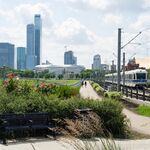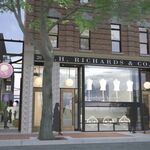TravellingChris
Active Member
Again, the numbers rest on the assumptions that potential passengers (the car drivers of today) will see sufficient advantages in riding the Valley Line LRVs that they don't currently see in buses, that will make them willing to forsake the car and overlook the many drawbacks of the line: the undersized shelters and bitterly cold platforms, the lack of signal priority at every intersection, the inevitable delays from the many accidents (consider the train wreck waiting to happen at 82 and 83, where the line not only crosses the street at grade but wanders from the median to the west side, meaning that drivers from all directions will have to stop--oh, and there will be no crossing gates). The projected numbers are lovely IF they translate into actual footfall in the stations, I mean bus shelters on the Valley Line.A bus is fundamentally different from a low-floor LRT. Just like a bus is different from a streetcar. The numbers back this up. According to the mass transit report that came out a few months back, the low floor Valley Line will serve more passengers per hour than the high floor Metro Line.
"High Floor LRT (Capital and Metro Line): 150 passengers per car, and 750 passengers per 5-car train. With the Capital Line running at 5 min headway and Metro Line running at 10 min headway during the morning peak hour (for the 1.25 Million horizon), the total capacities will be 9,000 passengers per hour per direction (pphpd) for the Capital line and 4,500 passengers per hour per direction (pphpd) for the Metro Line. Low Floor LRT (Valley Line): 225 passengers per car, and 450 passengers per 2-car train. With 5 min headway during the morning peak hour, the total capacity for Valley Line will be 5,400 passengers per hour per direction."
Note that even a one-car valley line train will have much more capacity than even an articulated bus, which has - at best - half that capacity (our newest articulated buses have 53 seats, plus however many riders can fit standing up).
Here's a visualization; note that the Valley Line is projected to serve many more people than even the bus routes that are assumed to be on their own rights of way with priority signals.
View attachment 395267
Here's some more data, plus a visualization in case you're more of a visual person.
View attachment 395269
View attachment 395268
So, let's say you wanted a BRT system that had the capacity of the valley line. After all, it's basically the same thing, and we already have garages and buses, right? Wrong. Not only would we need to do the same sort of infrastructure work (minus track laying), and not only are buses much more inefficient because of their rubber tires, but we would not have nearly the right number of buses. Look at this fleet comparison:
View attachment 395277View attachment 395278
If we need 34 LRVs for the Valley Line, and each can carry at least 2x the number of passengers, you'd be looking at at least an additional 64 buses plus the infrastructure to store them plus the staffing to operate and maintain them (and staffing is already one of transit's largest expenses). And you'd really need to double that figure, since the LRVs can run in two-car segments while buses cannot.
Would that end up being cheaper or more expensive than the LRT? Beats me, I'm not smart enough to crunch those numbers. But it would be a major undertaking nonetheless, for a system that is much less efficient than rail-based modes. Again though, one of our LRT's greatest champions (Gerry Wright) believed that the low-floor system was the 'true' LRT, so who am I to say that it's actually a glorified bus when the numbers back him up over 40 years later?
The Metro Line projections are a little unfair given that the short NAIT platform means only three car trains can be used, and the lengthy headways are due in large part to the mess of the signalling system that City planners themselves chose, and the fact that the line was built with so many curves and grade crossings that it cannot run at the trains' normal speed.
I note that in Option A the Capital Line still has almost double the passenger capacity of Valley Line, though. Which ties into my original point: I never suggested that buses were the proper substitute for the Valley Line. I believe the Valley Line should have been done similarly and used the same technology as the Capital Line. The point about buses is that we are getting a system that has most of the disadvantages of the bus system we already have, and few to none of the advantages of high floor LRT. If that's what we wanted, then we could have thrown up another hangar and bought a bunch more buses from New Flyer and been done with it long ago.





